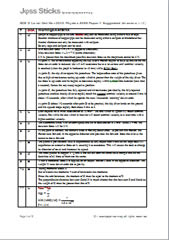Hello again everyone.
Once again, my 师姐 and I have drafted list of suggested answers for this year’s Physics 5058 MCQ Paper 1, which appears to contain a fair bit of bizarre controversies pertaining to skydiving, weird diodes, push-ups etc.
With all the “Confirm I’m right and you’re wrong!!!!!” flying around, please leave a comment if you spot any mistake, typo and/or wish to violently disagree with clarify any of the explanations given.
Good luck for those of you with your remaining papers! WE’RE ALMOST THERE!!!





 Miss Loi is a full-time private tutor in Singapore specializing in O-Level Maths tuition. Her life’s calling is to eradicate the terrifying LMBFH Syndrome off the face of this planet. For over years she has been a savior to countless students …
Miss Loi is a full-time private tutor in Singapore specializing in O-Level Maths tuition. Her life’s calling is to eradicate the terrifying LMBFH Syndrome off the face of this planet. For over years she has been a savior to countless students … 





















35 Comments
曜
日
I have some doubts about question 29 on the diode one. Will put my explanation tmr see if it sounds logical to you because my answer is C instead. Hope there will be answer for the chem paper tmr too 😀
曜
日
@Aaron: Okie let's discuss this tomorrow and good luck for your chem (if you're taking) *puts on armour*
曜
日
wah sian la. so many careless mistakes. 33/40 pray hard i can get my a2 or even better scrape out an a1. time to burn some extra joss sticks
曜
日
Why can't question 1 be B? I thought it is possible to use the micrometer to measure thickness of the copper pipe?
曜
日
@uthopia: This is unfortunately one of those ambiguous ones ...
To find the volume of the copper in the pipe, we subtract the volume obtained from its outer diameter do by the volume obtained from its inner diameter di i.e.
Volume of copper =
As the outer diameter is already known to be 2 cm, we'll need to measure its inner diameter which may be directly measured by calipers (via its inside jaws) or indirectly by subtracting 2 × its thickness measured by a micrometer (its thickness should be well within the range of a micrometer since outer diameter is only 2cm).
However to measure its "several metres long" length l it's more appropriate to use a tape rather than a rule, which typically can only measure up 1-2 metres (including those your cher used to smack your palms in days of yore ...) so the best answer in this context is D.
Of course there are the counter-arguments that tape measures are also called "retractable flexible rule", or how long exactly is "several meters" etc. so I do hope B can be accepted as well.
I'll have to amend and update the explanation for Q1 in the solutions later ...
曜
日
In my opinion, answer for question 3 is D.
I dare say this because at C, I think the parachute is not completely open yet. That's why it's still deccelerating for such a long period of time (which is aprox 5 sec).
At D, the parachute is already at the constant speed which indicates that the parachut is fully open. And it's 1-2s before landing so even better, we can see that the parachute is already open at D.
I'm not like 100% sure if my suggestion is reasonable but I guess it worth suggesting.. Actually I saw some guy doing skydiving and I noticed that he immediately reached a very low constant speed when the parachute was open completely. It took a while to decelerate when he opened at first because the parachute was not open fully yet.
Lol this question is so controversial... I hate doing this :/
曜
日
The rock and planet question should be A, not B. The rock changes direction and slows down. the rock has inertia so it should resist the change in motion caused by the planet's gravitational pull. it should slow down. much like how asteroids slow down as they reach a planets orbit, unless they are directly impacting the planet.
曜
日
Hi Little Miss Loi. I like this website a lot as it is a good source of info. For Q17, shouldn't it be C? For option B, it says 'air is a poor conductor of heat and STOPS the heat...'. Even though air is a poor conductor of heat, it will still conduct heat, but more slowly, and the rate of conduction of heat by air is mayb so slow that it will not produce the specific latent heat of fusion or specific heat capacity of water; thus ice remains cold. The word 'stops' in B is very suspicious. As for C, it looks more like the answer to me. Opinions?
曜
日
@tormented: Q17) It is baked in a very hot oven. The metal dish conducted heat from the oven surroundings to the ice cream (hotter to lower).
B may be vague in the sense that it 'stops' heat but its the most suitable answer.
曜
日
@tormented: The good heat conductivity of the metal dish in an oven is more to facilitate the transfer of heat energy into
whoeverwhatever's being cooked inside. If it can conduct heat away from the ice cream to keep it cold the moment it's taken out of the oven, then our sponge cake would have to become ice-cold as well - not very tasty isn't it?In this question, the pudding is placed in a very hot oven until the top of the egg whites turns
almost chao tarbrown. In such a horrifying scenario, the poor ice-cream would've melted in an instant if not forAnd yup I fully agree with you that being a poor conductor will never completely stop all heat from reaching the ice-cream. But in this context, the air bubbles within the very hot egg whites can almost be considered to be 'stopping' the heat from melting the ice cream that it is in contact with.
As Charis has mentioned, in the absence of a better answer (maybe something about the sponge cake being a poor conductor of heat as well?), B is the best option we have here.
I'll update the solutions with this added explanation later ...
曜
日
@Little Miss Loi: Alright I surrender. Perhaps this is how international exams like UCLES GCE O Level are like. They toy with our mind, our language, and our souls. Mayb next time should shade all options. Toy with their PMCAS-assessing machine.
曜
日
@tormented: You do that, they'll toy with your grades. 🙂
曜
日
yikes, overlooked the cm for qns 13 ><
5072/01 over, looking forward to the suggested answers. But still gt Bio...
曜
日
The answer to Question 4 is apparently D - same initial acceleration and same terminal velocity because terminal velocity is affected by surface area, and since they both have the same size and shape, it should be the same. Clarification?
曜
日
@charis: To save a bit of time, I'll quote this wall of text from wikipedia:
Basically in Q4, both objects start with the same acceleration i.e. g (~10 m/s2) when dropped.
As they fall, air resistance increases and their velocities will continue to increase as long the air resistance is less than their weight (there is a net resultant force downwards ⇒ acceleration) until the point where their respective terminal velocities are reached (i.e. air resistance = their weight ⇒ net resultant force is zero ⇒ no acceleration)
As illustrated in the diagram above, it will take a shorter time (t1) for the air resistance to be equal to the weight of the lighter object.
At this point, the lighter object stops accelerating and maintains its terminal velocity v1 but at the same time the air resistance has not yet matched the weight of the heavier object and hence it continues to accelerate ... until it has reached its own higher terminal velocity v2 at the later time t2.
I'll update the solutions with the diagram later ...
曜
日
according to your explanation, why is option B not chosen for qn 29?
曜
日
@maggie: Since there is only one diode in the circuit, half-wave rectification is performed.
From the diagram for option A below, the diode is forward biased in intervals 0 to 1 and 2 to 3, and hence a current flows through the circuit (when p.d. > 6) and there is a p.d. of 0.2 V across the resistor.
For intervals 1 to 2 and 3 to 4 in the diagram, the diode is reverse biased. Current flow is prohibited and hence there is no p.d. across the resistor during these intervals, so option B (and D) is ruled out.
曜
日
@Little Miss Loi: Question 29 the one on diode why is the answer not C?
"The diode only starts to conduct when there is a potential difference (p.d.) across it greater than 0.6V in one direction" means that it will only conduct 0.2V because it didnt allow the 0.6V to pass?
But the p.d. supplied is always 0.8V alternating and the 0.8V exceeds the 0.6V, so does that mean that the whole 0.8V should pass? Besides, they are talking about potential DIFFERENCE. Should it be than even if the current cannot flow to the resistor via the other end, the p.d. should still be 0.8V? On the bottom wire, potential is at 0.8V. On top, it can be at 0V if the diode is reverse biased and 0V also if the diode is forward biased since the 0.8V will get 'consumed' by the resistor?
After talking so much I now think that the answer is D leh. I think there may be a trick in the word "potential difference"? Don't know ...
Anyway I'm looking forward to the pure chem paper 1 answer.
曜
日
Chemistry Paper! 😀
曜
日
@Rahdom: Here! 😀
曜
日
What a paper! What's your lowest score here??
曜
日
dnt agree with qstn 36
曜
日
for qstn 36, if i am not wrong..the max induced emf occurs at the higher part of the coil not in the center. and is that is the case,this is a poor qstn as its based on assumption..so if the magnet is still able to pass thru the top of the coil at least half of it,i think it will have higher emf as it has higher speed- Vsq = Usq + 2AS
曜
日
oh and so my conclusion is raising the spring will inc max induced emf
曜
日
@hie: Typically in such a scenario, the magnitude of the induced e.m.f. depends on:
With the first two factors being constant in our scenario (assuming we don't anyhow go and play with the spring), since the strength of the magnet's magnetic field is weaker the farther from the magnet, raising the spring higher and effectively locating the magnet farther away will decrease the maximum emf that can be induced.
I suppose you are referring to the textbook example of inducing emf via moving a magnet in and out of a solenoid. In that experiment, the induced emf is higher "at the higher part of the coil" because the magnet is still moving (high rate of change of magnetic flux). Textbook diagrams typically show no induced emf when the magnet is inside the coil with the sole reason being that the magnet is momentarily stationary (before it changes direction).
However, if you were to move the magnet at the same speed both inside and outside the coil, you'll actually get a higher induced emf inside the coil since more turns of wire are 'cutting' through the magnetic field as the magnet moves through the coil.
曜
日
hello! any chances you'll upload the suggested answers for o'levels 2010 combined science(phy,chem) 5116/01 soon? hope to check the answers asap 😀 thank you!
曜
日
@charrrr: If you're still awake, here's a late night treat for you!
Will continue my attempt to catch up with the comments tomorrow.
曜
日
will u be posting the mcq ans for pure chem ?
曜
日
@joanne: Hi I uploaded the answer in my twitter. @mich_caulfield you can trust the source because it's from our school HOD.
曜
日
@Michelle: Sorry, I just kaypoh-ed your twitter account and found this:
DDBDB ABBCB BBBCA BBCBC ABBCD BDDBD AABDC CADAA
If these are the pure chemistry answers your are referring to, then mine tally with yours 100%! Yay!
曜
日
I disagree with 3 and 7. As you reach terminal the drop in speed is greater at b than at C. Therefore, C cannot possibly be the answer, as the drop in speed should surely be more when the chute is opened than when it has not yet.
I also disagree with 7. The planet's gravitational pull is TOWARDS ITS CENTRE. This means, if the rock is not going towards the centre, it would pull the rock towards its centre, thereby decreasing its speed towards its original trajectory. The rock also resists this new force acting upon it by its inertia, causing it to have a force on the opposite direction against the gravitational pull. Therefore, it changes direction, and decreases in speed. unless it was headed towards the CENTRE of the planet, but from the diagram, we can see that it was not.
曜
日
Is 35/40 safe?
曜
日
Hello. I think the answer for question 4 is D. Coz terminal velocity is affected by the surface area only?
曜
日
Physics really ain't friendly at all :/
曜
日
Why is there no Paper 2 answer key?